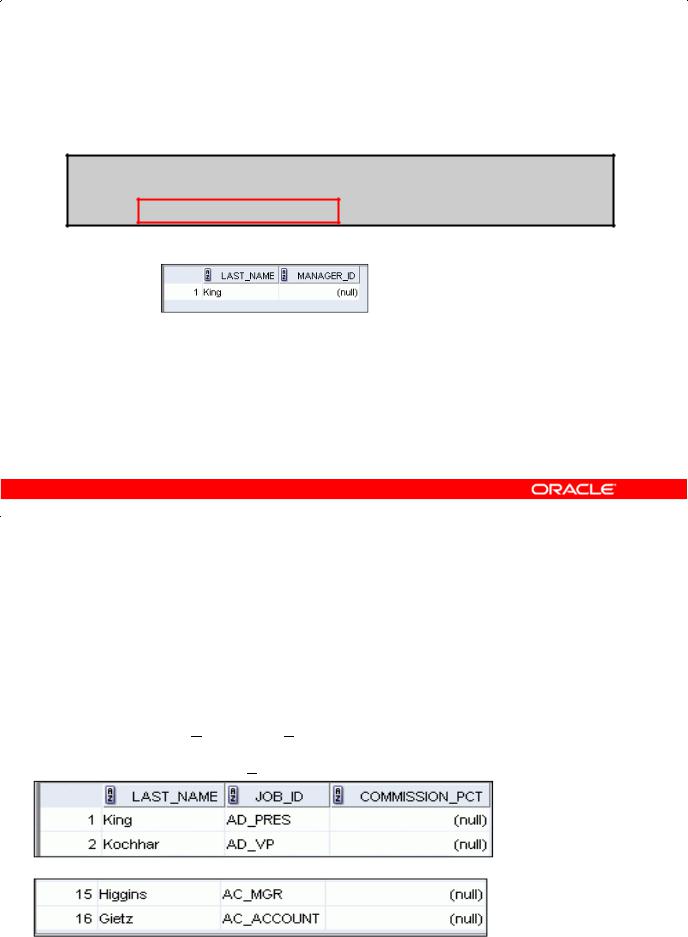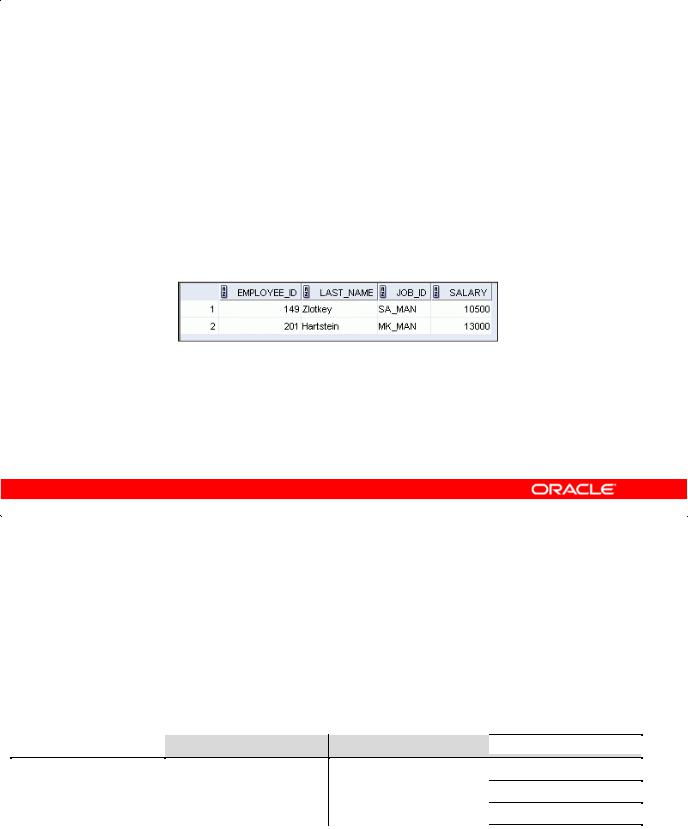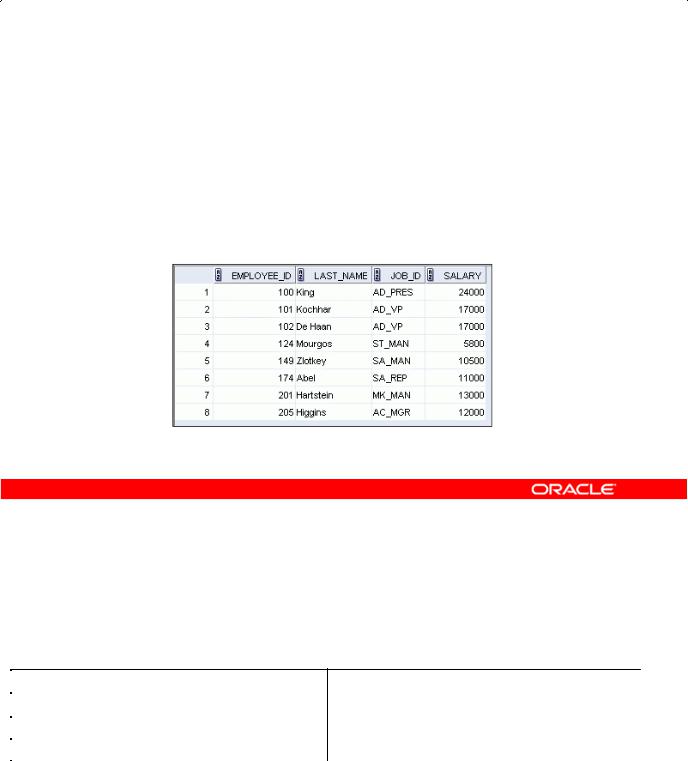
- •Preface
- •Introduction
- •Lesson Objectives
- •Lesson Agenda
- •Course Objectives
- •Course Agenda
- •Appendixes Used in the Course
- •Lesson Agenda
- •Oracle Database 11g: Focus Areas
- •Oracle Database 11g
- •Oracle Fusion Middleware
- •Oracle Enterprise Manager Grid Control 10g
- •Oracle BI Publisher
- •Lesson Agenda
- •Relational and Object Relational Database Management Systems
- •Data Storage on Different Media
- •Relational Database Concept
- •Definition of a Relational Database
- •Data Models
- •Entity Relationship Model
- •Relating Multiple Tables
- •Relational Database Terminology
- •Lesson Agenda
- •Using SQL to Query Your Database
- •SQL Statements
- •Development Environments for SQL
- •Lesson Agenda
- •The Human Resources (HR) Schema
- •Tables Used in the Course
- •Lesson Agenda
- •Oracle Database 11g Documentation
- •Additional Resources
- •Summary
- •Practice I: Overview
- •Objectives
- •Lesson Agenda
- •Capabilities of SQL SELECT Statements
- •Basic SELECT Statement
- •Selecting All Columns
- •Selecting Specific Columns
- •Writing SQL Statements
- •Column Heading Defaults
- •Lesson Agenda
- •Arithmetic Expressions
- •Using Arithmetic Operators
- •Operator Precedence
- •Defining a Null Value
- •Null Values in Arithmetic Expressions
- •Lesson Agenda
- •Defining a Column Alias
- •Using Column Aliases
- •Lesson Agenda
- •Concatenation Operator
- •Literal Character Strings
- •Using Literal Character Strings
- •Alternative Quote (q) Operator
- •Duplicate Rows
- •Lesson Agenda
- •Displaying the Table Structure
- •Using the DESCRIBE Command
- •Quiz
- •Summary
- •Practice 1: Overview
- •Objectives
- •Lesson Agenda
- •Limiting Rows Using a Selection
- •Limiting the Rows That Are Selected
- •Using the WHERE Clause
- •Character Strings and Dates
- •Comparison Operators
- •Using Comparison Operators
- •Range Conditions Using the BETWEEN Operator
- •Membership Condition Using the IN Operator
- •Pattern Matching Using the LIKE Operator
- •Combining Wildcard Characters
- •Using the NULL Conditions
- •Defining Conditions Using the Logical Operators
- •Using the AND Operator
- •Using the OR Operator
- •Using the NOT Operator
- •Lesson Agenda
- •Rules of Precedence
- •Lesson Agenda
- •Using the ORDER BY Clause
- •Sorting
- •Lesson Agenda
- •Substitution Variables
- •Using the Single-Ampersand Substitution Variable
- •Character and Date Values with Substitution Variables
- •Specifying Column Names, Expressions, and Text
- •Using the Double-Ampersand Substitution Variable
- •Lesson Agenda
- •Using the DEFINE Command
- •Using the VERIFY Command
- •Quiz
- •Summary
- •Practice 2: Overview
- •Objectives
- •Lesson Agenda
- •SQL Functions
- •Two Types of SQL Functions
- •Single-Row Functions
- •Lesson Agenda
- •Character Functions
- •Case-Conversion Functions
- •Using Case-Conversion Functions
- •Character-Manipulation Functions
- •Using the Character-Manipulation Functions
- •Lesson Agenda
- •Number Functions
- •Using the ROUND Function
- •Using the TRUNC Function
- •Using the MOD Function
- •Lesson Agenda
- •Working with Dates
- •RR Date Format
- •Using the SYSDATE Function
- •Arithmetic with Dates
- •Using Arithmetic Operators with Dates
- •Lesson Agenda
- •Date-Manipulation Functions
- •Using Date Functions
- •Using ROUND and TRUNC Functions with Dates
- •Quiz
- •Summary
- •Practice 3: Overview
- •Objectives
- •Lesson Agenda
- •Conversion Functions
- •Implicit Data Type Conversion
- •Explicit Data Type Conversion
- •Lesson Agenda
- •Using the TO_CHAR Function with Dates
- •Elements of the Date Format Model
- •Using the TO_CHAR Function with Dates
- •Using the TO_CHAR Function with Numbers
- •Using the TO_NUMBER and TO_DATE Functions
- •Using the TO_CHAR and TO_DATE Function with RR Date Format
- •Lesson Agenda
- •Nesting Functions
- •Lesson Agenda
- •General Functions
- •NVL Function
- •Using the NVL Function
- •Using the NVL2 Function
- •Using the NULLIF Function
- •Using the COALESCE Function
- •Lesson Agenda
- •Conditional Expressions
- •CASE Expression
- •Using the CASE Expression
- •DECODE Function
- •Using the DECODE Function
- •Quiz
- •Summary
- •Practice 4: Overview
- •Objectives
- •Lesson Agenda
- •What Are Group Functions?
- •Types of Group Functions
- •Group Functions: Syntax
- •Using the AVG and SUM Functions
- •Using the MIN and MAX Functions
- •Using the COUNT Function
- •Using the DISTINCT Keyword
- •Group Functions and Null Values
- •Lesson Agenda
- •Creating Groups of Data
- •Creating Groups of Data: GROUP BY Clause Syntax
- •Using the GROUP BY Clause
- •Grouping by More than One Column
- •Using the GROUP BY Clause on Multiple Columns
- •Illegal Queries Using Group Functions
- •Restricting Group Results
- •Restricting Group Results with the HAVING Clause
- •Using the HAVING Clause
- •Lesson Agenda
- •Nesting Group Functions
- •Quiz
- •Summary
- •Practice 5: Overview
- •Objectives
- •Lesson Agenda
- •Types of Joins
- •Joining Tables Using SQL:1999 Syntax
- •Qualifying Ambiguous Column Names
- •Lesson Agenda
- •Creating Natural Joins
- •Retrieving Records with Natural Joins
- •Creating Joins with the USING Clause
- •Joining Column Names
- •Retrieving Records with the USING Clause
- •Using Table Aliases with the USING Clause
- •Creating Joins with the ON Clause
- •Retrieving Records with the ON Clause
- •Creating Three-Way Joins with the ON Clause
- •Applying Additional Conditions to a Join
- •Lesson Agenda
- •Joining a Table to Itself
- •Self-Joins Using the ON Clause
- •Lesson Agenda
- •Nonequijoins
- •Retrieving Records with Nonequijoins
- •Lesson Agenda
- •INNER Versus OUTER Joins
- •LEFT OUTER JOIN
- •RIGHT OUTER JOIN
- •FULL OUTER JOIN
- •Lesson Agenda
- •Cartesian Products
- •Generating a Cartesian Product
- •Creating Cross Joins
- •Quiz
- •Summary
- •Practice 6: Overview
- •Objectives
- •Lesson Agenda
- •Using a Subquery to Solve a Problem
- •Subquery Syntax
- •Using a Subquery
- •Guidelines for Using Subqueries
- •Types of Subqueries
- •Lesson Agenda
- •Single-Row Subqueries
- •Executing Single-Row Subqueries
- •Using Group Functions in a Subquery
- •The HAVING Clause with Subqueries
- •What Is Wrong with This Statement?
- •No Rows Returned by the Inner Query
- •Lesson Agenda
- •Multiple-Row Subqueries
- •Lesson Agenda
- •Null Values in a Subquery
- •Quiz
- •Summary
- •Practice 7: Overview
- •Objectives
- •Lesson Agenda
- •Set Operators
- •Set Operator Guidelines
- •The Oracle Server and Set Operators
- •Lesson Agenda
- •Tables Used in This Lesson
- •Lesson Agenda
- •UNION Operator
- •Using the UNION Operator
- •UNION ALL Operator
- •Using the UNION ALL Operator
- •Lesson Agenda
- •INTERSECT Operator
- •Using the INTERSECT Operator
- •Lesson Agenda
- •MINUS Operator
- •Using the MINUS Operator
- •Lesson Agenda
- •Matching the SELECT Statements
- •Matching the SELECT Statement: Example
- •Lesson Agenda
- •Using the ORDER BY Clause in Set Operations
- •Quiz
- •Summary
- •Practice 8: Overview

Using the NULL Conditions
Test for nulls with the IS NULL operator.
SELECT last_name, manager_id
FROM employees
WHERE manager_id IS NULL ;
Copyright © 2009, Oracle. All rights reserved.
Using the NULL Conditions |
Academy |
|
|
The NULL conditions include the IS NULL condition and the IS NOT NULL condition. |
|
The IS NULL condition tests for nulls. A null value me ns that the value is unavailable, unassigned, unknown, or inapplicable. Therefore, you cannot test with =, because a null cannot be equal or
unequal to any value. The slide example retrieves the last names and managers of all employees who |
|||
do not have a manager. |
Oracle |
||
& |
|||
|
|
||
Here is another example: To display the ast name, job ID, a d commission for all employees who |
|||
are not entitled to receive a commission, use the followingOnlySQL statement: |
|||
SELECT |
last name, job id, commission_pct |
||
FROM |
employ s |
|
|
WHERE |
commission pct IS NULL; |
||
|
|
Use |
|
Internal |
|||
Oracle |
|
|
|
Oracle Database 11g: SQL Fundamentals I 2 - 14

Defining Conditions Using the Logical Operators
Operator |
Meaning |
|
|
AND |
Returns TRUE if both component conditions |
|
are true |
|
|
OR |
Returns TRUE if either component condition |
|
is true |
|
|
NOT |
Returns TRUE if the condition is false |
|
|
Copyright © 2009, Oracle. All rights reserved. |
Academy |
Defining Conditions Using the Logical Operators |
A logical condition combines the result of two componentOracleconditions to produce a single result based
on those conditions or it inverts the result of a single condition. A row is returned only if the overall result of the condition is true.
• AND |
& |
Only |
• NOT |
||
• OR |
|
|
|
Use |
|
Internal |
|
|
All the examples so far have specified only one condition in the WHERE clause. You can use several |
||
conditions in a single WHERE clause using the AND and OR operators. |
||
Oracle |
|
|
Oracle Database 11g: SQL Fundamentals I 2 - 15

Using the AND Operator
AND requires both the component conditions to be true:
SELECT |
employee_id, last_name, job_id, salary |
|
FROM |
employees |
|
WHERE |
salary >= 10000 |
|
AND |
job_id LIKE '%MAN%' |
; |
|
|
|
Copyright © 2009, Oracle. All rights reserved.
Using the AND Operator |
Academy |
|
In the example, both the component conditions must be true for any r cord to be selected. Therefore,
only those employees who have a job title that contains the string ‘MAN’ and earn $10,000 or more |
|||||||
are selected. |
|
|
|
|
|
|
|
All character searches are case-sensitive, that is no rows are returned if ‘MAN’ is not uppercase. |
|||||||
|
|
|
|
Oracle |
|
|
|
Further, character strings must be enclosed with quotation marks. |
|
|
|||||
AND Truth Table |
|
& |
Only |
|
|
||
|
|
|
|
|
|
|
|
The following table shows the results of combining two expressions with AND: |
|||||||
|
AND |
TRUE |
|
FALSE |
NULL |
|
|
|
|
|
UseFALSE |
NULL |
|
||
|
TRUE |
TRUE |
|
||||
|
FALSE |
FALSE |
|
FALSE |
FALSE |
|
|
|
|
Internal |
|
|
|
|
|
|
NULL |
NULL |
|
FALSE |
NULL |
|
|
|
Oracle |
|
|
|
|
|
|
Oracle Database 11g: SQL Fundamentals I 2 - 16

Using the OR Operator
OR requires either component condition to be true:
SELECT |
employee_id, last_name, job_id, salary |
|
FROM |
employees |
|
WHERE |
salary >= 10000 |
|
OR |
job_id LIKE '%MAN%' |
; |
|
|
|
|
|
|
|
|
Copyright © 2009, Oracle. All rights reserved. |
Academy |
|||
|
|
|
|
|
|
|
|
||
Using the OR Operator |
|
|
Oracle |
||||||
|
|
|
|
|
|
||||
|
In the example, either component condition can be true for any r cord to be selected. Therefore, any |
||||||||
|
employee who has a job ID that contains the string ‘MAN’ or earns $10,000 or more is selected. |
||||||||
|
OR Truth Table |
|
|
|
|
|
|
|
|
|
The following table shows the results of combining two expressions with OR: |
||||||||
|
|
|
|
|
& |
Only |
|
|
|
|
|
OR |
|
TRUE |
|
FALSE |
|
NULL |
|
|
|
|
Internal |
|
|
|
|
||
|
|
TRUE |
|
TRUE |
|
TRUE |
|
TRUE |
|
|
|
|
|
|
Use |
|
|
|
|
|
|
FALSE |
|
TRUE |
|
FALSE |
|
NULL |
|
|
|
NULL |
|
TRUE |
|
NULL |
|
NULL |
|
Oracle |
|
|
|
|
|
|
|||
Oracle Database 11g: SQL Fundamentals I 2 - 17
